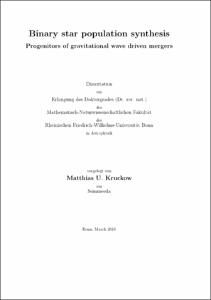Kruckow, Matthias U.: Binary star population synthesis : Progenitors of gravitational wave driven mergers. - Bonn, 2018. - Dissertation, Rheinische Friedrich-Wilhelms-Universität Bonn.
Online-Ausgabe in bonndoc: https://nbn-resolving.org/urn:nbn:de:hbz:5n-51049
Online-Ausgabe in bonndoc: https://nbn-resolving.org/urn:nbn:de:hbz:5n-51049
@phdthesis{handle:20.500.11811/7580,
urn: https://nbn-resolving.org/urn:nbn:de:hbz:5n-51049,
author = {{Matthias U. Kruckow}},
title = {Binary star population synthesis : Progenitors of gravitational wave driven mergers},
school = {Rheinische Friedrich-Wilhelms-Universität Bonn},
year = 2018,
month = jun,
note = {The vast majority of all massive stars are born in binaries. The binarity of a star may influence its life drastically via a large variety of interactions with its companion star. Several astrophysical events, like the recently detected gravitational wave mergers, have a binary origin. To investigate the possible paths of binary evolution, a new stellar grid-based binary populations synthesis code ComBinE is developed.
During binary evolution, many uncertain phases, including one or more mass-transfer phases, a common-envelope phase and kicks during a supernova explosion, have to be considered. The least understood among them is the common-envelope phase. A detailed analysis of the consequences of the conversion of available energy reservoirs into the ejection of the gas of the common envelope is performed at two metallicities, that of the Milky Way (Z = 0.0088) and that of the dwarf galaxy IZwicky18 (Z = 0.0002). The most crucial aspect is the bifurcation point which separates the remaining core from the lost material.
ComBinE is applied to investigate a variety of parameters of the binary evolution phases and their effects on observable stages during the evolution leading to a final gravitational wave driven merger. The simulations performed with ComBinE are able to reproduce the observed Galactic double neutron star population with respect to their orbital parameters and, to some extend, their measured mass distributions. In addition, the simulations can reproduce the progenitor systems of all published merger events of double black hole mergers and the double neutron star merger, GW170817, for appropriate metallicities. Merger-rate densities in the local Universe are obtained from the simulations. Statistical uncertainties are discusses as well as predictions made for future observations and LIGO-Virgo detections.
Finally, using ComBinE, the nature of the unseen companion star in the radio pulsar binary PSR J1755−2550 is probed to narrow the search window for the companion.},
url = {https://hdl.handle.net/20.500.11811/7580}
}
urn: https://nbn-resolving.org/urn:nbn:de:hbz:5n-51049,
author = {{Matthias U. Kruckow}},
title = {Binary star population synthesis : Progenitors of gravitational wave driven mergers},
school = {Rheinische Friedrich-Wilhelms-Universität Bonn},
year = 2018,
month = jun,
note = {The vast majority of all massive stars are born in binaries. The binarity of a star may influence its life drastically via a large variety of interactions with its companion star. Several astrophysical events, like the recently detected gravitational wave mergers, have a binary origin. To investigate the possible paths of binary evolution, a new stellar grid-based binary populations synthesis code ComBinE is developed.
During binary evolution, many uncertain phases, including one or more mass-transfer phases, a common-envelope phase and kicks during a supernova explosion, have to be considered. The least understood among them is the common-envelope phase. A detailed analysis of the consequences of the conversion of available energy reservoirs into the ejection of the gas of the common envelope is performed at two metallicities, that of the Milky Way (Z = 0.0088) and that of the dwarf galaxy IZwicky18 (Z = 0.0002). The most crucial aspect is the bifurcation point which separates the remaining core from the lost material.
ComBinE is applied to investigate a variety of parameters of the binary evolution phases and their effects on observable stages during the evolution leading to a final gravitational wave driven merger. The simulations performed with ComBinE are able to reproduce the observed Galactic double neutron star population with respect to their orbital parameters and, to some extend, their measured mass distributions. In addition, the simulations can reproduce the progenitor systems of all published merger events of double black hole mergers and the double neutron star merger, GW170817, for appropriate metallicities. Merger-rate densities in the local Universe are obtained from the simulations. Statistical uncertainties are discusses as well as predictions made for future observations and LIGO-Virgo detections.
Finally, using ComBinE, the nature of the unseen companion star in the radio pulsar binary PSR J1755−2550 is probed to narrow the search window for the companion.},
url = {https://hdl.handle.net/20.500.11811/7580}
}






